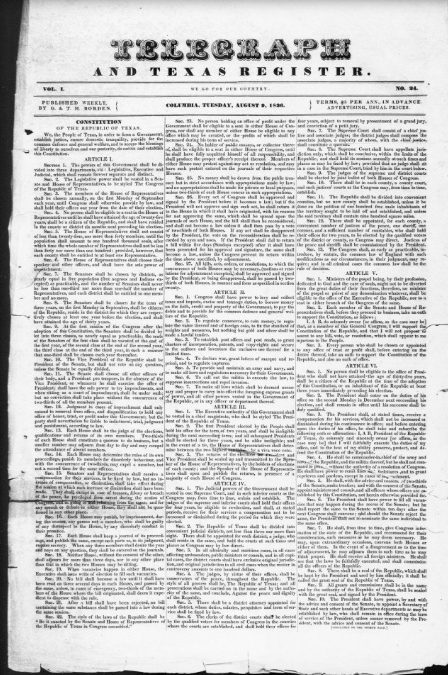![]()
By SUSAN AVERA HOLT
Columbia Historical Museum Board Member
In 1836, Stephen F. Austin’s colonists relied on the Telegraph and Texas Register newspaper for notices of land for sale, crop reports, passenger manifests and social events. The weekly paper also carried news of the Mexican army, the Texas Constitution (yes, the entire document), elections for a new government and much more.
The paper first was printed in San Felipe de Austin on Oct. 10, 1835. Publishers were brothers Gail Borden, Jr. and Thomas H. Borden, along with Joseph Baker. During the battles for Texas’ independence from Mexico, the paper was an important tool, communicating all sorts of news to isolated colonists. Settlers in that wild land had no mail service, and the newspaper was the only way to relay reliable information.
In the spring of 1836, the battle for Texas was at its height: the Alamo fell, civilians fled before the Mexicans in the Runaway Scrape and finally independence was won at the Battle of San Jacinto.
The Telegraph and Texas Register was in the thick of the mayhem, and in the Aug. 2, 1836, edition, the publishers offered this bit about the paper’s calamities during this tumultuous time in Texas’ history.
“As it is now three months and a half since our last paper (No. 22, 14th of April) was published, we trust to be excused when on this occasion, we become a little talkative, in giving a sketch of the history of the death of our typographical concern.
“Our army retreated from the Colorado on the 2th of March and reached San Felipe the next day, at night. On the 28th and 29th, with the assistance of Capt. Baker’s company, we crossed with our press, the river, which commenced rising on the 1st April, and before teams could be procured we were compelled to make a raft to traverse the back-water, which had come up between the Brazos and prairie.
“It was the Government’s intention to remove the Press from Harrisburg, and the steam-boat had arrived for the purpose of taking it and other property away, but the enemy came unawares into the town, took three of our workmen prisoners, and amidst the conflagration that ensued, our establishment was consumed.”
For good measure, the Mexicans threw the presses into Buffalo Bayou.
Once the battles were over, Texas began crafting a government for the new country. One of the first orders of business was to find a newspaper to communicate news. The newspaper’s press was used to print more than just the paper. Anyone could commission documents to be printed.
The paper set up shop in Columbia, the Congress of the Republic convened and the birth of Texas was recorded in the pages of The Telegraph and Texas Register. Copies of the paper are rare, and most people will probably never see the printed page, however, anyone can go online and read every word.
The National Digital Newspaper Program https://www.loc.gov/ndnp/is bringing back early newspapers. The program is a partnership between the Library of Congress and the National Endowment for the Humanities. Begun in 2005, the long-term effort is developing an internet-based, searchable database of U.S. newspapers. The digital resource will be permanently maintained at the Library of Congress. Visit loc.gov/ndnp to learn more about it.
All 50 states are now participating in the program. The Texas Digital Newspaper Program partners communities, publishers and institutions to promote digitization of Texas newspapers. The Portal to Texas History, https://texashistory.unt.edu/ housed at the University of North Texas, is an invaluable resource to genealogists, researchers, journalists and students. To date, more than 855,453 items have been scanned and are available through the portal.
More than 5,270 pages are Brazoria County based and more than 170 years of history are preserved on the portal. The success of the program begins with sharing resources and sending them to the University of North Texas (UNT) for scanning. The Brazoria County News, which served Brazoria, Sweeny and West Columbia for more than 30 years, is currently at UNT being digitized through financial support from the Tocker Foundation.

The Telegraph and Texas Register operated in Columbia in 1836.

The Telegraph and Texas Register carried a list of people running for the first offices of the new country of Texas.

